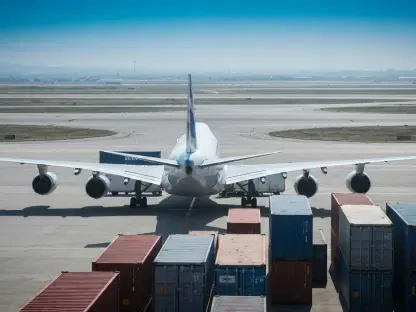Imagine a truck loaded with high-value goods parked at a bustling terminal, only to vanish overnight, costing a company hundreds of thousands of dollars in losses, a scenario that is becoming alarmingly common as cargo theft surges across the U.S. supply chain. This trend disrupts freight markets and drives up costs. With losses averaging over $200,000 per incident, the Department of Transportation (DOT) has stepped in with a determined crackdown. This roundup gathers insights, opinions, and strategies from various stakeholders—industry leaders, law enforcement, and federal agencies—to explore the depth of this crisis and the multifaceted approaches being proposed to combat it. The goal is to illuminate the challenges, compare differing viewpoints, and highlight actionable solutions for a more secure freight network.
Unpacking the Cargo Theft Epidemic: Stakeholder Concerns
Cargo theft has evolved into a critical threat, impacting not just economic stability but also fueling broader criminal activities such as narcotics trafficking. Reports indicate a staggering 90% increase in incidents in recent years, painting a grim picture of vulnerability across transportation modes. Industry representatives have voiced frustration over the lack of resolution in many cases, pointing to inconsistent reporting as a significant barrier to understanding the full scope of the problem. Their perspective underscores an urgent need for better data collection to track theft patterns effectively.
Law enforcement agencies, on the other hand, emphasize the complexity of tackling both opportunistic thefts and organized crime networks. They argue that multi-jurisdictional coordination remains a persistent challenge, often allowing thieves to exploit gaps between state and local boundaries. Their input highlights how fragmented efforts hinder swift responses, suggesting that federal oversight could play a pivotal role in unifying strategies to deter criminals.
Federal agencies contributing to the DOT’s initiative stress the importance of viewing cargo theft as a systemic supply chain flaw rather than solely a policing issue. Their stance focuses on long-term resilience, advocating for policies that address root causes like regulatory loopholes exploited by unethical carriers. This broader lens aims to integrate prevention into the very framework of transportation operations, setting it apart from more immediate enforcement-focused views.
Dissecting Theft Types and Vulnerabilities: Diverse Opinions
Straight Thefts vs. Strategic Networks: Contrasting Challenges
Industry analysts often break down cargo theft into two primary categories: straight thefts, involving the physical stealing of goods from trailers or terminals, and strategic networks that employ fraud, cyber tactics, and insider collusion. Many in the trucking sector note that straight thefts are more visible and frequent at high-traffic stops, making them easier to target with basic security measures. However, they caution that the sheer volume of such incidents overwhelms current resources, demanding more robust on-ground protections.
Conversely, technology experts within the logistics field argue that strategic theft networks pose a graver, less predictable threat due to their sophistication. They point out that fraudulent carriers and cyber-enabled schemes often go undetected until significant damage is done, with losses compounding quickly. Their perspective pushes for investment in advanced digital tools to trace and prevent these intricate crimes before they escalate.
A third viewpoint from security consultants bridges these concerns, suggesting that both theft types feed into each other, creating a cycle of vulnerability. They advocate for a balanced approach that combines physical safeguards with cybersecurity measures to address the dual nature of the issue. This integrated strategy seeks to disrupt the interconnected web of theft operations, rather than tackling each form in isolation.
High-Risk Hubs and Modes: Where Opinions Diverge
When it comes to vulnerabilities across transportation modes, port and terminal operators often highlight multimodal exchange points like seaports and airports as prime targets due to the high value and volume of goods. They argue that the complexity of these hubs creates blind spots, making theft easier to execute amidst the chaos of operations. Their focus is on localized interventions, such as enhanced surveillance at these critical nodes, to curb incidents.
Rail and air freight stakeholders, however, contend that their sectors face unique challenges tied to the speed and scale of movement, which limit the window for security checks. They suggest that theft in these modes often ties into larger organized crime, necessitating broader intelligence-sharing networks rather than site-specific fixes. This viewpoint shifts the conversation toward systemic collaboration over isolated protective measures.
Law enforcement perspectives add another layer, emphasizing how unchecked theft at any transportation point can fund more dangerous criminal enterprises. They urge prioritizing high-risk commodities across all modes, advocating for federal resources to map and secure supply chain weak spots. This comprehensive approach contrasts with more mode-specific concerns, aiming to address the ripple effects of theft on national security.
Strategies for Defense: Tips and Solutions from Experts
Data and Coordination: Building a Unified Front
A recurring theme among supply chain consultants is the pressing need for improved data visibility to combat fragmented reporting. They recommend standardized systems that allow real-time tracking of theft incidents, enabling quicker identification of patterns and hotspots. Their tip is for companies to adopt centralized reporting platforms, which could feed into a national database supported by federal initiatives.
Law enforcement voices complement this by stressing the value of multi-jurisdictional intelligence sharing to counter the cross-border nature of many thefts. They suggest that federal agencies take the lead in creating frameworks where local and state forces can access shared resources, reducing response delays. This strategy focuses on breaking down silos that currently hinder effective enforcement.
Technology providers offer a forward-looking angle, pointing to innovations like blockchain and IoT devices as game-changers for cargo security. Their advice to businesses is to invest in these tools for better traceability and tamper-proof records, which could deter strategic theft networks. This tech-driven solution contrasts with traditional coordination efforts, highlighting a blend of modern and conventional tactics.
Stakeholder Collaboration: Best Practices and Innovations
Industry leaders involved in the DOT’s outreach emphasize the importance of collaborative defense strategies, particularly in protecting high-value commodities. They propose regular joint forums with law enforcement to share best practices, such as driver training programs to spot suspicious activity. Their practical tip is for firms to prioritize internal education as a first line of defense against insider threats.
Federal agency contributors focus on regulatory innovation, suggesting that closing loopholes for unethical carriers could reshape prevention efforts over the coming years. They encourage testing new compliance measures to ensure carriers operate transparently, reducing opportunities for fraud. This policy-oriented approach seeks to address structural weaknesses that other stakeholders might overlook.
Security specialists round out the discussion with a call for performance metrics to evaluate the success of anti-theft initiatives. They advise businesses to track incident rates and recovery times as indicators of progress, fostering accountability across the supply chain. This analytical perspective aims to quantify the impact of collaborative efforts, providing a benchmark for continuous improvement.
Reflecting on the Collective Effort to Secure Supply Chains
Looking back, the roundup of perspectives on cargo theft revealed a shared recognition of its profound threat to the U.S. supply chain, coupled with a diversity of approaches to address it. Industry, law enforcement, and federal voices converged on the need for better data and coordination, while differing on the balance between immediate security and systemic reform. The dialogue showcased a blend of practical tips, from standardized reporting to tech investments, alongside broader strategies like regulatory tweaks. Moving forward, stakeholders are encouraged to engage actively with the DOT’s framework, prioritizing partnerships that bridge operational and policy gaps. Exploring further resources on supply chain security and joining collaborative platforms can amplify these efforts, paving the way for a more fortified freight network.









